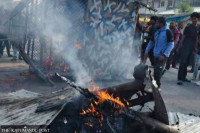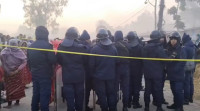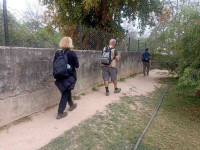National
Kathmandu-Kerung railway project "complicated and arduous," report says
Complicated geological terrain and laborious engineering workload will become the most significant obstacles to building a cross-border railway line linking the Chinese border town of Kerung with Kathmandu, according to a classified feasibility study by a Chinese firm on the much-touted project.
Anil Giri
Complicated geological terrain and laborious engineering workload will become the most significant obstacles to building a cross-border railway line linking the Chinese border town of Kerung with Kathmandu, according to a classified feasibility study by a Chinese firm on the much-touted project.
The report, which was obtained exclusively by the Post, said the railway line, which has to pass through the rugged Himalayan high mountains would involve orchestrating complex construction plans, raising questions about whether the most hyped infrastructure project in Nepal will see to its end.
Following an agreement signed by Prime Minister KP Oli during his visit to Beijing in June, the China Railway First Survey and Design Institute conducted a month-long technical study of the proposed 121-kilometre railway from Kathmandu to Kerung.
Earlier on Sunday, the Chinese firm invited Nepali delegation to discuss the technical outcome of the project in the north central city of Xi’an, home to the famous Terracota Army sculptures. The four-day meeting, which begins next week, is expected to examine the report and reach a conclusion on how to ease the complexities before preparing the final project report.
A senior member of the delegation representing Nepal in Xi’an told the Post that once a detailed project report is in place, the two countries will agree on a financial modality before the construction of railway track begins.
“We can only suggest the political leadership whether the project is technically or financially doable or not,” said the official, who did not want to be named because he was not authorised to speak.
“Ultimately, the onus lies on leaders in both countries to decide whether they want to go ahead with the construction of the railway track.”
However, details in the report indicate that both governments have to consider significant technical and financial hurdles before even considering finalising the project.
According to the report, engineers would build ramps along the northern and southern slopes leading to Lake Paiku, near Kerung, to connect the tracks to the Kathmandu section. The goal of the ramps would be to overcome the huge difference in elevation between the southern and northern toes of the Himalayan mountains.
The report highlighted that the Kathmandu section of the railway is in the “collision and splicing zone” along the Eurasian Plate, presenting six major geological problems. First, the hard rock burst and the large deformation of soft rocks would cause extremely high stress. Second, the problem of the fault effects of the deep, active fractures are located in high-intensity seismic areas.
During the geological examination, the report said, the level of seismic activities could present problems with high ground temperatures, slope stability, debris and water erosion.
In the project, the section with the longest and most steep grade is up to 95 km long out of 121 km. The report says continuous use of air braking will cause serious abrasion of the brake shoe, tire overheating, and other potential operational dangers in the rail.
Senior officials at the Department of Railways in Kathmandu said the track is a research lab and it’s no surprise that building those would be technically challenging.
“We will examine the report thoroughly with our Chinese counterparts who will also propose some kind of model to fund the project,” said Prakash Upadhyaya, the senior divisional engineer at the department. Nepali officials are still unsure about which model can be adopted in the project that could cost over $3 billion.
It’s also unclear which country will foot what share of the construction costs for the railway line that’s expected to take five to seven years to build.
Nepali officials have repeatedly said the meeting in Xi’an will involve discussions of all constraints and challenges, including clarity on financial obligations involving the project.




 16.12°C Kathmandu
16.12°C Kathmandu













%20(1).jpg&w=300&height=200)

